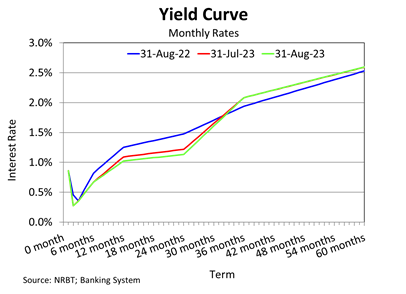Demand for housing loans on the rise
- Details
- Category: Economic Release
- Created: 29 January 2016
| Banking Sector Developments November 2015 |
||||
| Nov 15 | Oct 15 | Sep 15 | Aug 15 | |
| Deposit rate (%) * |
2.18 | 2.29 | 2.29 | 2.27 |
| Lending rate (%) * |
8.07 | 8.09 | 8.27 | 8.26 |
| Total Deposits (T$m) |
412.6 | 407.8 | 403.9 | 399.8 |
| Total Lending (T$m) | 441.8 | 436.2 | 427.9 | 422.4 |
| New commitments (T$m) | 11.5 | 14.9 | 13.5 | 10.5 |
| Broad Money (T$m) | 427.8 | 428.7 | 422.3 | 424.2 |
| * Weighted Average calculated as a function of interest rate and volume of deposits and loans | ||||
Demand for housing loans on the rise
Lending
Banks competition and low interest rates have contributed to a strong demand for housing loans. Banking data for the month of November 2015 has revealed that business loans and particularly housing loans continue to rise recording credit growth of 1.2% over the month and 12.0% over the year. The consecutive growth in housing loans coupled with rises in businesses’ construction loans showed encouraging signs for the housing and construction industry.
Business lending
Banks’ lending to businesses increased slightly over the month by 0.4% to $154.7 million, resulting mainly from increases in lending to the construction and manufacturing sectors. The government’s managed funds loan scheme partially supported the increase in manufacturing loans. Including government on-lent loans, total lending to businesses only rose by 0.3% due to loan repayments. In year ended terms, total bank lending to businesses increased by 8.5%, reflecting major loans extended to public enterprises and increases in loans to the manufacturing, construction and trade sectors. However, including government on-lent loans, annual business lending increased only by 7.5%, reflecting declines in government on-lent loans.
Household lending
Banks’ lending to households rose over the month by 1.8% to $167.5 million, due to an increase in housing and other personal loans. Including lending from South Pacific Business Development (SPBD) and Retirement Fund Board (RFB), total lending to households also increased over the month by 2.2%. In year ended terms, total household lending increased by 15.5%, reflecting increases in housing loans and other personal loans. Including loans extended by SPBD and RFB, annual household lending increased further by 17.4%.
Other lending
Other loans from banks increased over the month by 2.7% but fell by 7.6% over the year, driven mainly by lending activities within the non-profit institutions sector.
Non-performing loans
Total non-performing loans for the banking system increased over the month by 2.1% to $25.0 million, which represents 7.7% of total loans. About 50% of total non-performing loans were businesses whilst households comprise only 28.6%. However, total non-performing loans fell over the year by 18% underpinned by a decline in household non-performing loans.
Deposits
Total bank deposits grew over the month by 1.2% to $412.6 million, due mainly to an increase in demand and term deposits. The increase in demand deposits was driven by a rise in business deposits whilst non-profit institutions drove the higher term deposits. Bank deposits also increased over the year by 15.4% due to increases in all categories. Demand deposits increased the fastest over the year with government the main contributor.
Interest rates spread
Banks weighted average interest rate spread widened over the month from 5.80% to 5.89% in November. Weighted average deposit rate fell from 2.29% to 2.18% more than a 1.8 basis points fall in weighted average lending rate which resulted in the wider spread over the month. However, weighted average interest rate spread narrowed over the year by 41 basis points with weighted average lending rate to businesses declining the fastest. Increased competitions among banks to maintain its existing good customers and also to attract new clients have resulted in the higher number of low interest loans to businesses.
Broad money
Broad money slightly fell over the month by 0.2% to $427.8 million, resulting mainly from a 2.2% decline in net domestic assets, offsetting a 0.6% rise in net foreign assets. The decline in net domestic assets was due to a 2.2% rise in capital accounts particularly bank shares and other equity while an increase in foreign reserves led the higher net foreign assets. In year ended terms, broad money increased by 13.4% underpinned by increases in net domestic assets and net foreign assets. Total domestic demand deposits and currency in circulation also increased over the year in line with the rise in broad money.
Liquidity
Banking system liquidity increased slightly over the month by 0.3% to $171.1 million underpinned by the increases in foreign reserves and demand deposits. Over the year to November 2015, banking system liquidity increased by 18.6%, reflecting the increases in foreign reserves and bank deposits.
Outlook
Credit growth is supported by the continuous improvements in business confidence, improving economic conditions and annual events. Continued competition amongst banks and the ongoing lending activities of the Government’s managed funds will continue to support the current low lending rates. The NRBT is forecasting credit growth to continue to grow by more than 10% in the next six months. The NRBT will continue to promote prudent lending and closely monitor credit growth in light of the impact on the monetary policy targets and financial stability.
Download the Banking Sector Development report of November for more information and figures.

